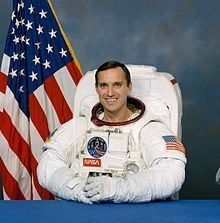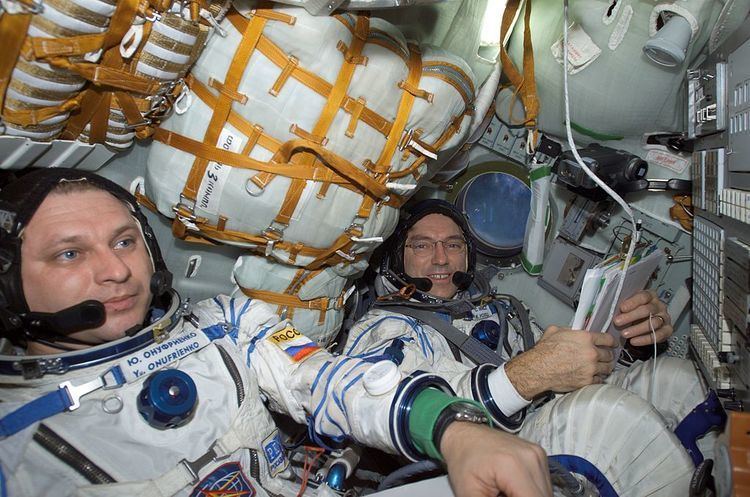Nationality American Time in space 230d 13h 04m Role Astronaut | Other occupation Engineer Name Carl Walz Status Retired Mission insignia Space agency NASA | |
 | ||
Similar People Daniel W Bursch, William F Readdy, Frank L Culbertson - Jr, James H Newman, Terrence W Wilcutt | ||
Carl Erwin Walz (Colonel, USAF, Ret.) (born September 6, 1955) is a former NASA astronaut currently working for Orbital Sciences Corporation's Advanced Programs Group as Vice President for Human Space Flight Operations. Walz was formerly assigned to the Exploration Systems Mission Directorate at NASA Headquarters in Washington, DC. He was the Acting Director for the Advanced Capabilities Division in the Exploration Systems Mission Directorate, and was responsible for a broad range of activities to include Human Research, Technology Development, Nuclear Power and Propulsion and the Lunar Robotic Exploration Programs to support the Vision for Space Exploration.
Contents

Personal data

Born September 6, 1955, in Cleveland, Ohio. Married to the former Pamela J. Glady of Lyndhurst, Ohio. They have two children. He enjoys piano and vocal music, sports, and was the lead singer for Max Q, a rock-n-roll band comprising astronauts.
Education

Graduated from Charles F. Brush High School, Lyndhurst, Ohio, in 1973; received a bachelor of science degree in physics from Kent State University, Ohio, in 1977, and a master of science in solid state physics from John Carroll University, Ohio, in 1979.
Organizations

American Legion, Kent State University Alumni Association, John Carroll University Alumni Association, and the Association of Space Explorers.
Honors
Graduated Summa Cum Laude from Kent State University. Awarded the Defense Superior Service Medal, the USAF Meritorious Service Medal with one Oak Leaf Cluster, the Defense Meritorious Service Medal with one Oak Leaf, the USAF Commendation Medal, and the USAF Achievement Medal with one Oak Leaf Cluster. Distinguished Graduate from the USAF Test Pilot School, Class 83A. Inducted into the Ohio Veterans Hall of Fame. Awarded three NASA Space Flight Medals, NASA Exceptional Service Medal. Distinguished Alumnus Award, Kent State University, 1997.
Experience
From 1979 to 1982, Walz was responsible for analysis of radioactive samples from the United States Atomic Energy Detection System at the 1155th Technical Operations Squadron, McClellan Air Force Base, California. The subsequent year was spent in study as a flight test engineer at the U.S. Air Force Test Pilot School, Edwards Air Force Base, California. From January 1984 to June 1987, Walz served as a Flight Test Engineer to the F-16 Combined Test Force at Edwards Air Force Base, where he worked on a variety of F-16C airframe avionics and armament development programs. From July 1987 to June 1990, he served as a Flight Test Manager at Detachment 3, Air Force Flight Test Center.
NASA experience
Selected by NASA in January 1990, Walz is a veteran of four space flights, and has logged 231 days in space. He was a mission specialist on STS-51 (1993), was the Orbiter flight engineer (MS-2) on STS-65 (1994), was a mission specialist on STS-79 (1996), and served as flight engineer on ISS Expedition 4 (2001–2002). Carl Walz and fellow astronaut Dan Bursch currently hold the U.S. space flight endurance record of 196 days in space.
Space flight experience
STS-51 Discovery (September 12–22, 1993). During the mission, the five-member crew deployed the U.S. Advanced Communications Technology Satellite (ACTS), and the Shuttle Pallet Satellite (SPAS) with NASA and German scientific experiments aboard. Walz also participated in a 7-hour space walk (EVA) to evaluate tools for the Hubble Space Telescope servicing mission. The mission was accomplished in 9 days, 22 hours, and 12 minutes.
STS-65 Columbia (July 8–23, 1994). STS-65 flew the second International Microgravity Laboratory (IML-2) spacelab module, and carried a crew of seven. During the 15-day flight the crew conducted more than 80 experiments focusing on materials and life sciences research in microgravity. The mission completed 236 orbits of the Earth, traveling 6.1 million miles, setting a new flight duration record for the Shuttle program.
STS-79 Atlantis (September 16–26, 1996). On STS-79 the six-member crew aboard Atlantis docked with the Russian Mir station, delivered food, water, U.S. scientific experiments and Russian equipment, and exchanged NASA long duration crewmembers. During the mission, the Atlantis/Mir complex set a record for docked mass in space. STS-79 was the first flight of the double Spacehab module, and landed at KSC after 10 days 3 hours and 13 minutes.
The Expedition 4 crew launched on December 5, 2001 aboard STS-108 and docked with the International Space Station on December 7, 2001. During a 6½ month stay aboard the Space Station, the crew of three (two American astronauts and one Russian cosmonaut) performed flight tests of the station hardware, conducted internal and external maintenance tasks, and developed the capability of the station to support the addition of science experiments. The crew spent 196 days in space establishing a U.S. space flight endurance record for Carl Walz and crew mate Dan Bursch. Wearing the Russian Orlan space suit, Walz logged 11 hours and 52 minutes of EVA time in two separate spacewalks. The Expedition 4 crew returned to Earth aboard STS-111, with Endeavour landing at Edwards Air Force Base, California, on June 19, 2002.
